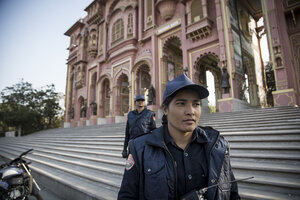Fighting sexism, India's police ask: When is 'women only' good for women?
A vicious gang rape in 2012 spurred a groundswell for reform to combat rampant harassment and gender-based violence. Some police have turned to all-female patrols and stations – but the approach has plenty of critics. Part 6 of Reaching for Equity: a global series on gender and power.

Members of the newly launched female police squad in Jaipur, India, patrol near a city gate Jan. 19.
Ahmer Khan/Special to The Christian Science Monitor
Jaipur, India
For Tanvi Tamwar, a college senior in this northwest Indian city famous for its pink sandstone monuments, getting to school used to mean running a daily gantlet.
“Often there were suspicious men on the bus who made all kinds of remarks to you. Right up to the school entrance there would be groups of boys hanging around, Eve-teasing,” she recalls, using the local expression for India’s rampant sexual harassment.
Then last May the Jaipur police introduced all-female police units: two women per motorbike to patrol hotspots such as bus stops, shopping malls, parks – and the gates of female schools and colleges like Ms. Tamwar’s.
“We feel safer and a little more free when these patrols are here” the sociology major says, standing with friends in the courtyard of Pareek PG Girls College. “It’s true that when the lady police are gone some of those boys come back. But overall it’s positive.”
Jaipur’s 28 all-female units, among the first in India, are just one manifestation of a deep national soul-searching over the scourges of sexual harassment and gender-based violence – and police’s role in fighting them. Along with all-female police stations, they’re meant to encourage more women to come forward and report abuse. But the question for many women’s groups is whether such “all women” initiatives can change the underlying attitudes that so often allow it to go unchecked. Many argue they are little more than window dressing, letting top brass contend they are addressing women’s safety while in fact shunting it aside.
In 2012, India was shaken by the vicious gang rape of a young woman on a private bus in New Delhi. The attack lasted more than an hour; neither the police nor any witness intervened. The victim, who became known as Nirbhaya – Hindi for “fearless” – died from her injuries.
Huge demonstrations erupted in protest at what women’s groups decried as a culture of rape that either downplays sexual crimes or holds the victims to blame, while trivializing harassment by dismissing it as “boys will be boys” Eve-teasing.
The “Nirbhaya effect” has led to special courts to speed the adjudication of sexual-violence cases, and to tougher rape sentences. The public outcry has also prompted a raft of police reforms designed to show that the force is serious about tackling gender-based crimes.
The outcry could also account for a recent increase in the number of reported rape cases. New Delhi police data show a 67 percent jump in such cases from 2012 to 2016, but experts differ over whether the figures reflect a real increase in the number of incidents, or simply better reporting.
Women helping women
In Jaipur, the capital of conservative Rajasthan state, the all-female patrol units are the latest move in a police campaign to enhance women’s security. The city also has four all-women police stations, envisioned as places where abused and threatened women can feel safe airing sometimes very private complaints with female officers.
India has hundreds of such police stations, many of which predate the Nirbhaya case. But it’s the female patrol units that have put Jaipur in the national spotlight, making the city a focal point for the debate over women in policing and gender-based violence.
The only real solution, say some activists, is to increase the number of women in the police force – they currently make up less than 10 percent of officers – and to make sexual harassment a matter for everyday police work.
“By and large these parallel all-women police stations don’t work and in fact are a distraction from the central objective, which is the mainstreaming of women into the police,” says Devika Prasad, coordinator of the police reforms program at the Commonwealth Human Rights Initiative in New Delhi.
“Women need to be integrated into all levels of police work and not just relegated to the back office,” she argues.
Sanjay Agarwal, Jaipur’s Commissioner of Police, wouldn’t disagree. Currently, only 12 percent of his officers are women, but he says that “the ideal police station would be 50 percent women, with those women working at all levels of police work and the public seeing them at all levels of authority.
“Those are the goals the government is directing us to reach,” he points out.
But such reforms do not happen overnight. In the meantime, he says, “we are doing things that put the women officers we have in the frontlines. And we are taking steps that will help women who have had some atrocity committed against them not feel intimidated, but empowered to come to the police.”
And come to the police they do. At a weekly meeting of Jaipur’s all-female patrol units, the stories that their 56 members tell illustrate how young women, especially, are turning to them.
One by one, the “lady constables,” dressed in crisp navy uniforms and blue caps, stand to report their experiences over the previous week. One tells of a 13-year-old girl who ran to her to complain about older boys pursuing her and taunting her in a nearby park; another recounts how a university student approached her about a young man threatening to put her picture on social media and post lies about her relationships with men if she didn’t agree to befriend him.
Then discussion turns to the frequently-reported problem of young men on motorbikes who verbally harass women and sometimes physically intimidate them.
Kamal Shekhawat, the deputy police commissioner in charge of the female patrol squads, tells the officers to take down the motorbikes’ registration numbers or to advise the young women to do so.
Ms. Shekhawat, who gave up a university teaching career to join the police, says those weekly reporting sessions remind her why India needs female police squads and its “1090” dedicated women’s emergency helpline.
“Five years isn’t very much time for society to change,” she says, referring to the Nirbhaya case and the subsequent groundswell for reform. “So while we are taking important steps like increasing the number of women police officers and implementing gender-sensitivity training for all our officers, we also have to remember we’re serving a very conservative, traditional population that changes slowly.”
Push back, push forward
Renuka Pamecha, a prominent women’s rights veteran who heads the Protect Jaipur Women organization, says she does not see even slow progress.
“The national mindset is not changing,” Ms. Pamecha continues. “Women are more educated and more aware of their rights, and laws are changing, but the society remains orthodox and we see the reaction to the empowering of women in all these cases of violence against women.”
Pamecha no longer sees all-women police stations as the solution she once thought they would be. Although individual women might feel more comfortable going to such stations, she acknowledges, she does not feel that “segregation” helps the broader struggle for women’s rights. All-female patrols may help, she says, but she suspects they may end up acting as a kind of "morality police," as patrols elsewhere in India have been accused of doing.
“In this country the boys need to learn how to socialize with girls, we need to raise boys’ awareness of the issues girls are facing,” she says. “And we’re not doing that.”
Still, a few hours spent at Jaipur’s Gandhinagar all-women police station offer evidence of its empowering effect.
The station’s captain, Veena Singh, receives a young woman who had filed a complaint against her husband weeks earlier, saying he turned abusive when he drank. Today she has returned, husband and young son in tow, to withdraw her complaint. She says notice of the complaint and the obligatory counseling that it entailed, have had a positive impact.
When Capt. Singh asks if what the wife says is true, the sheepish husband nods his head, yes. The complaint is withdrawn.
Later a woman wearing a purple shawl over a lime-green sari arrives with her mother and two children to complain about her husband. The couple has been arguing about installing a latrine, she says – ending “open defecation” is a sanitation priority for the Indian government – and he has become violent.
The desperate woman sought the advice of neighbors, who told her about the all-women police stations. The woman decided she was at a point where she had to do something, and even though the Gandhinagar station is far from her home, she came to tell her story.
“I knew I should go to the police, but I hesitated,” she says. “Then when I heard about this station, I was encouraged. I thought it would be easier to discuss my problem with other women.”
Her choice is a small victory for Jaipur’s policy of giving women the opportunity to talk to other women privately about their personal issues. And on the city’s streets, Tanvi Tamwar, the sociology student, says she has noticed the female police patrols making a difference, too.
“I think seeing these lady police is changing attitudes in many ways; even boys are changing in the way they are approaching girls,” she says. “Maybe not so fast, but there is change.”


